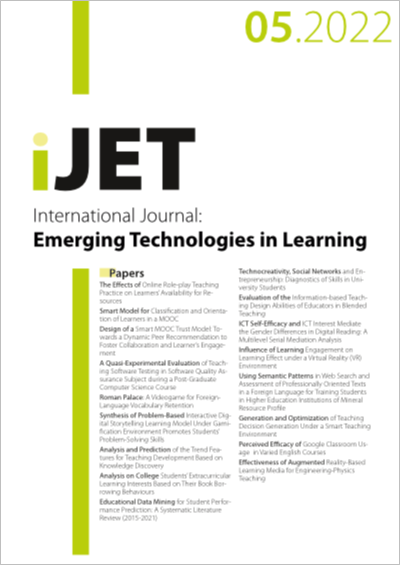Technocreativity, Social Networks and Entrepreneurship: Diagnostics of Skills in University Students
DOI:
https://doi.org/10.3991/ijet.v17i05.28183Keywords:
Tecnocreativity, Social media, Design thinking, Growth hacking, Entrepreneurship.Abstract
This paper presents the first exploratory results of a research integrated in a more global project on digital and entrepreneurial skills of students at the University ***. The study reveals gaps in professional skills such as problem solving, strategic thinking and creativity. For this reason, a pedagogical pro-ject is created integrating the use of social media in training (entrepreneur-ship), research (knowledge management) and university transfer. The aim is to develop skills in digital talent, (techno)creativity and to implement work methodologies, such as design thinking and growth hacking. In addition, it will encourage self-learning of the students, improve their e-competences, creative capacity and practical skills for a better adaptation to the needs of social demand, where knowledge transfer generates development and growth scenarios (startup) and fosters innovation (competitive capacity). This inno-vative initiative will enable Higher Education students to acquire the most demanded skills in a multidisciplinary labour market that also requires spe-cific ones in creativity, strategic capacity, project management, product in-novation, solution generation and entrepreneurship. This is what forms the basis of an integral project of triangular synergy between University, Busi-ness and Society.
Downloads
Published
2022-03-14
How to Cite
Comesaña-Comesaña, P., Amorós-Pons, A., & Alexeeva-Alexeev, I. (2022). Technocreativity, Social Networks and Entrepreneurship: Diagnostics of Skills in University Students. International Journal of Emerging Technologies in Learning (iJET), 17(05), pp. 180–195. https://doi.org/10.3991/ijet.v17i05.28183
Issue
Section
Papers
License
Copyright (c) 2022 Patricia Comesaña Comesaña, Anna Amorós-Pons, Inna Alexeeva-Alexeev

This work is licensed under a Creative Commons Attribution 4.0 International License.



